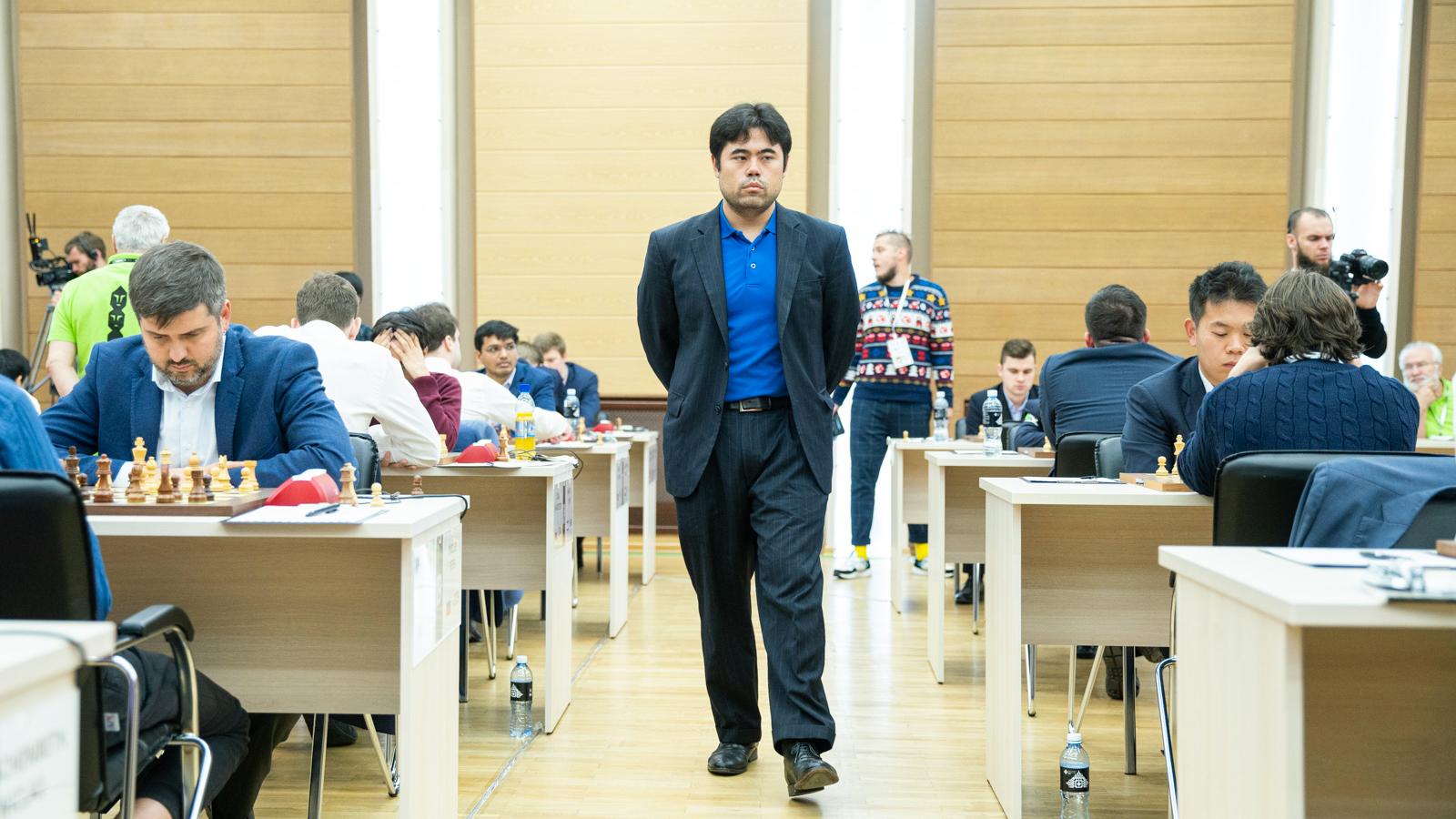Hikaru Nakamura started his second round at the FIDE World Cup with a loss and needs to beat Liviu-Dieter Nisipeanu on Saturday to stay in the tournament. Both spectacular attacks and special endgames were played in this round.
You can follow the games here as part of our live portal Chess.com/events. There is daily coverage by our Twitch partner, the Chessbrahs.
GMs Yasser Seirawan, Eric Hansen and Aman Hambleton are covering the tournament each day on their channel Twitch.tv/Chessbrah. Play starts at 3 p.m. local time, which is 12:00 (noon) CEST, 6 a.m. Eastern and 3 a.m. Pacific.
With only 64 participants left in the playing hall, the fourth day in Khanty-Mansiysk started with a shocker. Hikaru Nakamura played his moves in the opening fast, but alarm bells started to ring around his 14th as the engines didn’t like it at all. By then, his opponent Liviu-Dieter Nisipeanu had sacrificed his queen.
Nakamura played quickly till and including 14…e5.
It must have been a mixup of Nakamura’s preparation, because not just one, but two moves would promise White a clear advantage. After a 17-minute think, the long-haired, Romanian-German GM Nisipeanu chose what was the second line of the computer and some Naka fans might have breathed a sigh of relief, but in fact this move turned out to be very strong as well.

Nakamura took 28 minutes on his reply, and another 22 on the next, but eventually failed to hold the game as the position was just too easy to play for White.
“It’s not a pleasant feeling when you sacrifice something and your opponent continues to play quickly. Of course it doesn’t look good, but then I thought: I had to trust my feelings,” said Nisipeanu, who “expects to face a beast” for the return game.

The interview with Nisipeanu by FIDE.
There was one more upset in this round as 21st seed Wei Yi of China lost to 44th seed David Anton of Spain. Wei has a tough task on Saturday as he’ll be playing with the black pieces. Anton played an impressive game as he basically outplayed his opponent in a Giuoco Pianissimo:

A potential upset was 42nd seed Luke McShane getting in trouble against 106th seed Daniil Yuffa. This saw the rare endgame of two bishops versus a lone knight. For a long time this was considered to be a draw, but since the appearance of the tablebases we know for sure that it’s always winning for White. However, a checkmate or knight capture cannot be achieved within 50 moves against perfect defense.
Yuffa-McShane after 81.Bxh2.
It has been seen quite a few times in tournament practice, for instance in these grandmaster games:
- Botvinnik-Tal, 1961 (Tal won)
- Pinter-Bronstein, 1977 (draw)
- Popovic-Korchnoi, 1984 (draw)
- Timman-Speelman, 1992 (Timman won)
- Oll-Gelfand, 1998 (draw)
- Malakhov-Kuzubov, 2009 (Malakhov won)
In older times, FIDE had included a few endgames in its regulations in which players could try for 75 moves instead of 50, but nowadays these exceptions don’t exist anymore. (Not sure about this, earlier this year Magnus Carlsen himself asked an arbiter during a tournament game.)
Vladimir Malakhov‘s win vs Yuriy Kuzubov was all the more impressive as it was done in an era where games are not adjourned anymore. Jan Timman did have that luxury in 1992, and in fact he contacted a computer expert who had discussed this particular endgame with him eight years before, saying the machine had made considerable progress. Note that some tablebases existed, but were not easily available.
Timman’s opponent Speelman nervously looked at the fax machine at the hotel in Linares that was spitting out 56(!) pages of analysis, as the story goes (in Dutch here). The next day Timman needed only 15 more moves to win.
Yuffa failed to do so:

Speaking of special endgames… what about a position with five knights on the board? That’s not something you see every day either, and in fact it’s far more rare.
For something like this, Tim Krabbé is usually a good source. In his 1974 book Schaakcuriosa he discusses the game Szabo-Ivkov, Belgrade 1964 where this happened as well. If we look at grandmaster games, it only appeared one more time, in Sargissian-Pantsulaia, Aeroflot open 2004.
Promoting to any other piece wouldn’t have made sense because of a fork, so Anton Korobov underpromoted to a knight in a double knight endgame, which was a good way of fighting Le Quang Liem‘s three pawns:

The round was full of great attacking games as well. But before we go there, let’s check the moment where the top seed of the tournament was briefly in danger.
Ding Liren was better out of the opening, but Sergei Movsesian is a tough cookie and after the perhaps somewhat over-optimistic 22.h4 the Armenian GM just took the pawn, and gradually started to reduce White’s compensation.
Movsesian allowed his opponent to force a repetition with a sacrifice, but he could have played a move that both attacked and defended against that idea.
Levon Aronian had a much better start than in the first round. Thanks to a black win against Parham Maghsoodloo, the Armenian grandmaster is already close to reaching the third round.
Maghsoodloo can be a tricky player, especially in complicated positions, but in this one he stumbled:

Indian prodigy Nihal Sarin is so far fully justifying his nomination by the FIDE President. He played a model game in the Breyer Ruy Lopez against Eltaj Safarli. The Azerbaijani GM probably was never completely outplayed like this against a 15-year-old before. Total domination.

Shakhriyar Mamedyarov played one of the most attractive games of the round. He didn’t get much out of the opening, which is not surprising since Rustam Kasimdzhanov is one of the biggest opening experts in the world, but not castling against the Azerbaijani GM usually means asking for trouble.
As a modern-day Paul Morphy, Mamedyarov sacrificed on f7 to drag the enemy king into the center and the rest of the attack was spiced up with some more tactics.

Besides all the fireworks and remarkable endgames, there were also examples of pure technical chess, with the stronger player slowly outplaying their opponents based on will power and technique. If you have the time and patience to look at such games, they can be very instructive as well.
Maxime Vachier-Lagrave won this way against Igor Kovalenko:

Sergey Karjakin also took his time to beat Sam Sevian:

Good results were scored by some of the underdogs, who drew their first games as Black against opponents rated more than 100 points higher:
- Alexander Grischuk vs.Benjamin Bok
- Dmitry Andreikin vs. Rinat Jumabayev
- Kirill Alekseenko vs. Johan-Sebastian Christiansen
- Peter Svidler vs. Andrey Esipenko
- Ernesto Inarkiev vs. Xu Yiangyu
- Vidit Gujrathi vs. Aleksandr Rakhmanov
The “best” achievement here is that of Christiansen, who came to the playing hall thinking he had the white pieces! He came totally unprepared to the game, and later sent several tweets about it in a conversation with GM Jonathan Tisdall:
I just want to add that I was told that I was gonna play with the white pieces. I even asked one of the arbiters just to be 100% sure. He said I was gonna play white and I read the regulations, and also thought I was gonna play white.
— Johan-Sebastian Christiansen (@GMJSChr) September 13, 2019
So I sat down after talking to the chief arbiter for 10 minutes. I was absolutely disgusted by everything. The lack of information and false information from people working in the tournament. I had no clue about what his repertoire was, so I had to play some absolute bullshit
— Johan-Sebastian Christiansen (@GMJSChr) September 13, 2019
For a guy that has never played the World Cup or any type of knockout format, it is not obvious that since I beat the higher rated player, I will overtake his starting number. Which results in me “being the higher rated”.
— Johan-Sebastian Christiansen (@GMJSChr) September 13, 2019
So apparently I’m now playing as “Wojtaszek” and following his path. How on earth could I know that? And why didn’t anyone tell me. I even asked someone else to read the regulations to agree with me that I was gonna play white. They agreed.
— Johan-Sebastian Christiansen (@GMJSChr) September 13, 2019
I have absolutely no idea. This entire system seems Greek to me. It said in the regulations that the lower rated will switch the color from his first game. And since I am the lower rated, I understood that I was gonna switch, and play white.
— Johan-Sebastian Christiansen (@GMJSChr) September 13, 2019
FIDE World Cup | Round 2, day 1 results
| Seed | Fed | Title | Player | – | Seed | Fed | Title | Player | G1 | G2 | TB1 | TB2 | TB3 | TB4 | TB5 | TB6 | TB7 |
| 1 | GM | Ding Liren | – | 64 | GM | Movsesian | ½-½ | . | . | . | . | . | . | . | . | ||
| 2 | GM | Giri | – | 66 | GM | Najer | ½-½ | . | . | . | . | . | . | . | . | ||
| 3 | GM | Vachier-Lagrave | – | 62 | GM | Kovalenko | 1-0 | . | . | . | . | . | . | . | . | ||
| 4 | GM | So | – | 61 | GM | Demchenko | ½-½ | . | . | . | . | . | . | . | . | ||
| 5 | GM | Nepomniachtchi | – | 69 | GM | Predke | ½-½ | . | . | . | . | . | . | . | . | ||
| 6 | GM | Aronian | – | 59 | GM | Maghsoodloo | 1-0 | . | . | . | . | . | . | . | . | ||
| 7 | GM | Mamedyarov | – | 58 | GM | Kasimdzhanov | 1-0 | . | . | . | . | . | . | . | . | ||
| 8 | GM | Dominguez | – | 72 | GM | Abasov | ½-½ | . | . | . | . | . | . | . | . | ||
| 9 | GM | Grischuk | – | 73 | GM | Bok | ½-½ | . | . | . | . | . | . | . | . | ||
| 10 | GM | Radjabov | – | 55 | GM | Sjugirov | ½-½ | . | . | . | . | . | . | . | . | ||
| 11 | GM | Artemiev | – | 54 | GM | Cheparinov | 1-0 | . | . | . | . | . | . | . | . | ||
| 12 | GM | Yu Yangyi | – | 53 | GM | Adhiban | ½-½ | . | . | . | . | . | . | . | . | ||
| 13 | GM | Karjakin | – | 52 | GM | Sevian | 1-0 | . | . | . | . | . | . | . | . | ||
| 14 | GM | Nakamura | – | 51 | GM | Nisipeanu | 0-1 | . | . | . | . | . | . | . | . | ||
| 15 | GM | Andreikin | – | 79 | GM | Jumabayev | ½-½ | . | . | . | . | . | . | . | . | ||
| 17 | GM | Harikrishna | – | 48 | GM | Fedoseev | 1-0 | . | . | . | . | . | . | . | . | ||
| 18 | GM | Duda | – | 47 | GM | Nabaty | 1-0 | . | . | . | . | . | . | . | . | ||
| 19 | GM | Svidler | – | 83 | GM | Esipenko Andey | ½-½ | . | . | . | . | . | . | . | . | ||
| 20 | GM | Vitiugov | – | 84 | GM | Huschenbeth | ½-½ | . | . | . | . | . | . | . | . | ||
| 21 | GM | Wei Yi | – | 44 | GM | Anton | 0-1 | . | . | . | . | . | . | . | . | ||
| 22 | GM | Le | – | 43 | GM | Korobov | ½-½ | . | . | . | . | . | . | . | . | ||
| 25 | GM | Wang Hao | – | 40 | GM | Rodshtein | ½-½ | . | . | . | . | . | . | . | . | ||
| 27 | GM | Matlakov | – | 38 | GM | Gelfand | ½-½ | . | . | . | . | . | . | . | . | ||
| 28 | GM | Tomashevsky | – | 92 | GM | Aravindh | 1-0 | . | . | . | . | . | . | . | . | ||
| 29 | GM | Vidit | – | 93 | GM | Rakhmanov | ½-½ | . | . | . | . | . | . | . | . | ||
| 30 | GM | Jakovenko | – | 35 | GM | Jones | ½-½ | . | . | . | . | . | . | . | . | ||
| 31 | GM | Xiong | – | 95 | GM | Tabatabaei | ½-½ | . | . | . | . | . | . | . | . | ||
| 32 | GM | Firouzja | – | 33 | GM | Dubov | ½-½ | . | . | . | . | . | . | . | . | ||
| 42 | GM | McShane | – | 106 | GM | Yuffa | . | . | . | . | . | . | . | . | |||
| 41 | GM | Inarkiev | – | 105 | GM | Xu Xiangyu | ½-½ | . | . | . | . | . | . | . | . | ||
| 90 | GM | Nihal | – | 103 | GM | Safarli | 1-0 | . | . | . | . | . | . | . | . | ||
| 49 | GM | Aleksеenko | – | 113 | GM | Christiansen | ½-½ | . | . | . | . | . | . | . | . |
The FIDE World Cup takes place Sept. 9-Oct 4 in Khanty-Mansiysk, Russia. Each round consists of two classical games and a tiebreak on the third day. The final consists of four classical games. Both finalists will qualify for the 2020 Candidates’ Tournament. The total prize fund is $1.6 million (1.45 million euros). Sept. 19 and 29 are rest days. You can find more background info in our preview article.
Correction: an earlier version of this report erroneously stated that in 1992 tablebases did not exist yet.
Previous reports:
















